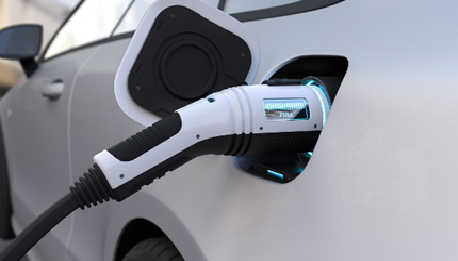Empowering Change: The Surging Demand for EV Chargers
The demand for Electric Vehicle (EV) chargers is steadily increasing, with many public charging stations being owned or operated by private charging network companies. Companies and entrepreneurs are making investments in EV charging stations, recognizing the revenue potential. This trend also includes investments in companies that operate public charging station networks and manufacture EV components. Consumers growing adoption of EVs can be attributed in part to high gas prices and growing concerns over greenhouse gas emissions and global warming. It also reflects the efforts of automakers to expand the number of moderately priced passenger EVs. Electric transportation got a height of support from the infrastructure investment and EV charging infrastructure.

Market Overview and Developments
The global EV charger market is expected to grow at a (CAGR) of 20.0% by 2032. This is attributed to the growing demand of finding a public fast charger that is compatible with various vehicles such as, electric car, truck, or SUV can be challenging. The key market players in the global EV charging market include ChargePoint, ABB, Eaton, Leviton, Blink, Schneider Electric, AeroVironment, Panasonic, Chargemaster, Elektromotive, Pod Point, BYD, NARI, Xuji, Potivio, Auto Electric Power Plant, Ruckus New Energy Tech, Huashang Sanyou, Wanbang, and Qingdao Telaidian.
The market growth is also driven by the employment of EV charging stations by various businesses and entrepreneurs to enhance their accessibility. Businesses that accommodate longer customer stays may benefit from installing EV charging stations. Several companies provide comprehensive EV charging solutions, including the installation of charging stations and charger software.

Business are coming up with carried EV charging services and technologies contributing significantly towards market growth. For instance, WattLogic and Energys offer EV charging station franchises. Energys also provides a website tool to calculate the potential profit from owning an EV charging station franchise.
The combined charging system is a common fast-charging standard found on many electric vehicles, excluding Tesla models. It is widely available at public charging stations operated by various companies such as Electrify America, ChargePoint, and EVgo. Vehicles such as the Kia EV6, Ford F-150 Lightning, Volkswagen ID.4, and Chevy Bolt, among others, are compatible with the CCS standard. In comparison to the Tesla/NACS standard, the CCS plug and charge port are relatively bulky. New non-Tesla cars featuring the CCS standard, and adapters for CCS-equipped EVs to charge at locations with Tesla-type plugs are set to be manufactured. These developments will enable non-Tesla vehicles to charge at supercharger stations.
The CHAdeMO fast-charging standard, commonly used by Nissan Leafs and plug-in hybrid versions of the Mitsubishi Outlander, features slightly smaller plugs and ports compared to CCS but are still larger than the Tesla/NACS standard. However, CHAdeMO generally offers slower charging speeds. Despite being less popular than other standards, CHAdeMO stations are still widely available.
Market Challenges
EVs have a typical range of 200-300 miles on a single charge, which is sufficient for the average American daily commute of 36 miles. However, longer trips and extreme weather conditions may necessitate daily charging. Currently, public Level 2 charging stations require 4-6 hours to provide 3-4 hours of driving range. Although EVs are not yet mainstream in India, there is increasing demand for them, and they are expected to become more prevalent in various vehicle categories.
EV charging and gasoline pricing structures differ, as gasoline is consistently priced by the gallon while EV charging can have varied pricing. This difference can lead to inconsistent pricing and higher charging costs, potentially hindering adoption due to consumer dissatisfaction. Utility regulators establish consistent rates per kWh for home charging, while public charging stations may have per-session fees, per-minute fees, or tiered pricing based on charging speed. EV drivers often prefer the per-kWh pricing structure, as it aligns closely with the per-gallon pricing structure they are accustomed to. In some states, per-kWh pricing models are combined with tiers based on charging speeds.
The availability of charging slots is crucial, and software development can streamline this process. For instance, Fortum India offers secure and user-friendly EV charging solutions through their application, Fortum Charge and Drive, which provides real-time data for locating chargers, managing payments, accessing customer support, and viewing charging history. The adoption of a green strategy by major private-sector automobile players suggests a potential rapid change in the automotive industry. EV charging stations require specialized technical safety measures to address concerns such as voltage fluctuations and overcurrent. Integrating stabilizers, proximity sensors, and control pilot sensors can help mitigate these issues and protect valuable components.
The differences in pricing structures between EV charging and gasoline, as well as the potential hindrances to EV adoption due to inconsistent pricing and higher charging costs. It also highlights the susceptibility of EV charging station components to failure and the risks associated with environmental factors and software glitches. The need for regular maintenance and effective thermal management systems to mitigate these issues is emphasized. Additionally, the increase in grid capacity required for the transition to electric vehicles and the shortage of charging stations contribute to range anxiety. The lower maintenance requirements of EVs compared to gasoline-powered vehicles but advises considering the potential replacement of costly components such as the battery packs.
Texas focused on the electrical demand that would arise if all personal cars, trucks, and SUVs in each state were converted to plug-in EVs. The shortage of charging stations in various regions of the country is contributing to an increase in range anxiety among EV users. The federal government has taken steps to address this issue, notably by enacting the Infrastructure Investment and Jobs Act in 2021. While EVs entail lower maintenance requirements compared to gasoline-powered vehicles, the potential replacement of costly components such as the battery pack should be considered. DC charging stations are large commercial facilities exclusively serving mid-sized to large 4-wheeler vehicles, supporting fast and turbocharging. AC charging stations are smaller and cater to 2-wheelers and rickshaws, supporting charging or battery exchange.
Encapsulating, the evolving landscape of EV charging infrastructure is poised for significant growth, driven by increasing EV adoption due to high gas prices and environmental concerns. The market is seeing substantial investment in both charging station networks and EV component manufacturing. Collaboration between governments, the private sector, and technology innovators is essential for widespread adoption. The introduction of the North American Charging Standard (NACS) by Tesla is set to simplify the charging process, enhancing convenience for non-Tesla EV owners. However, challenges such as standardization, interoperability, infrastructure, sustainability, electrical component failures, overheating, connector, inconsistent pricing, regular maintenance, and grid capacity expansion remain. Addressing these issues will be crucial for supporting the accelerating transition to electric transportation and alleviating range anxiety among users.